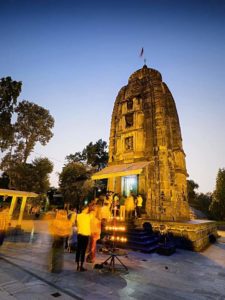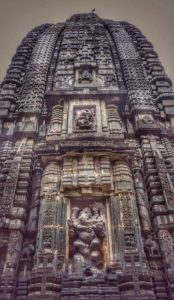By: Rusiraj PattanayakComes under the district of Mayurbhanj, the unfathomed land; Khiching is a historical village that was once the capital of Bhanja rules. The star attraction of this beautiful place is the Kichakeswari Temple which dates back to the year of 920 to 925 AD.
Kichakeswari Temple is made up of chlorite slabs and boasts an impressive Kalinga architectural design. However, the temple is believed to be the first temple of Odisha and because of this Khiching is known as the town with a rich heritage history. But, the architectural ruins recovered from this place said that the temple traces its history from the 8th to 9th century. It is also said that, once the town was a house of eight Shiva temples out of which seven can still be traced. At present, there are just three ancient temples left that worshiped Chandrasekhar, Kutaitundi and Kichakeswari.
This wonderful land of fascinating beauty and a long tradition of art and architecture, exquisite temples and historical monuments speak volumes of its past glory here. The Bhanja Kings were devout worshipers of Shakti as borne by the fact that Kichakeswari (Khijingeswari) or Chamunda was the tutelary deity of the Bhanja dynasty. Several images of Durga, Mahisasuramardini & Saptamatruka bear evidence of the popularity of Shaktism.

The existing temple of Goddess Kichakeswari is not the original one. It was during the rule of Maharaja Purna Chandra Bhanjdeo, that a systematic excavation of the Thakurani compound was first started by Raibahadur Rama Prasad Chand, who had been deputed for the purpose by Sir John Marsal at the request of the Maharaja. Mr. Chand during excavation of the Thakurani compound in (1922-24) came across the foundation of a great temple which measured 35’ square at the base.
The Report on the Administration of Mayurbhanj 1923-24, p.81 clearly records. “Foundations of the original temple in which the God Siva was enshrined have been traced. Over the shrine of the original temple stands small brick-built temple wherein the Goddess Kichakeswari is at present enshrined. At the request of local population of the Khiching, the Maharaja Purna Chandra Bhanja Deo & his brother, the Chotrai Saheb Pratap Chandra Bhanjdeo“…visited the shrine on 24th January, 1924 and promised to restore the original temple.
In his conservation note (J.A. Page), Assistant Superintendent of the Archaeological Survey of India, Central Circle, suggested that the brick-built shrine of the Thakurani be removed from the compound as its ugliness did not conform to the surroundings. The demolition of the shrine would make construction of a new shrine imperative, he wrote. At the request of the Maharaja, the Director General of Archaeology asked Mr. Page to make a plan for a simple structure of Indo-Aryan style. Since it was decided to use the doorjamb, door lintel and three images on the three niches of the old temple in the proposed new temple, the Khandiya deula (ruined temple) was demolished.
Therefore, the idea to arrange a plan/design was mooted.The weak foundation of the old temple was considered unsuitable for erecting the proposed new structure. The Administrative report of 1933-34 informs that the Maharaja was in favour of building a temple of Khiching style.
In 1924-25 the construction of a new temple for Goddess Kichakeswari was proposed and accordingly J.A. Page gave a plan of Indo-Aryan style of temple design. As the style of the Khiching temples were different from that of temples of other parts of Odisha, it was decided by the Maharaja to have a design of a temple of Khiching style.
The first thing Maharaja Purna Chandra did was to build a site museum for the better preservation of sculptures for which a large plot of land was acquired to extend the temple compound and to fence it with wire. The non-descript brick temple of the Goddess was demolished and removed from the compound. The Goddess was put in a newly constructed shed till a proper temple was built.

Due to tragic death of Maharaja Purna Chandra Deo in 1928 the progress in the matter was delayed for a few years. The actual rebuilding of the moden shrine of Kichakeswari could only begin in 1935, on the eve of the impending separation of Orissa from Bihar and its configuration into a separate provincial administrative unit. The modern shrine of Chamunda and the hut housing the kitchen of the temple were dismantled and the image of the goddess was shifted and re-consecrated in a make shift hut. The Khandiya Deul was dismantled, each stone marked carefully according to Page’s prescriptions (Plate Nos. 7.11 and 7.12); the new temple was then constructed stage by stage, reusing the architectural and sculptural fragments from the Khandiya Deula. The whole work of rebuilding the temple was carried out by the local masons of Khiching, under the direct supervision of S. P. Bose.
In April 1941, after the Mayurbhanj Durbar had spent nearly Rs. 80, 000 on the project, the work of building the new Kichakeswari shrine finally came to a close. In a four day long “Pratistha” ceremony, extending from 11 to 14 March 1942, and personally conducted by the Maharaja of Mayurbhanj, the image of goddess was re-consecrated in the new shrine.
The Goddess is seated on a lotus issuing from the naval of Purusa. Over the head and back of the Goddess rises the figure of Airavata. On other side of her crown there is a serpent with uplifted hood. Of the eight hands the left ones are in Abhaya and Varada poses and hold rosaries and a head where as two right hands hold a dambaru and a cup, the other two being completely damaged. Thus the temple of Goddess Kichakeswari is a priceless embodiment of superb charm and inimitable grace, and occupies a significant place among the famous monuments of Odisha, as a sacred sanctuary of religious activities and the Goddess Kichakeswari in the form of eight-armed Chamunda of Shaakta pantheon stands gloriously betokening the heyday of royal dignity and aristocracy.
Sources: A beautiful Article by Sri Bhakta Barik, Sri Ramaprasad Chand, Bhanja Dynasty of Mayurbhanj and their Ancient Capital Khiching;
Mayurbhanj: Sri P. Acharya, Archaeological Department, 1929.